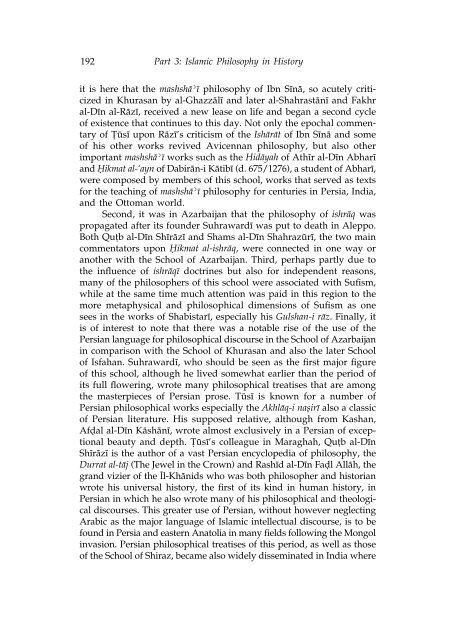Islamic Philosophy from Its Origin to the Present: Philosophy in the ...
Islamic Philosophy from Its Origin to the Present: Philosophy in the ...
Islamic Philosophy from Its Origin to the Present: Philosophy in the ...
You also want an ePaper? Increase the reach of your titles
YUMPU automatically turns print PDFs into web optimized ePapers that Google loves.
192 Part 3: <strong>Islamic</strong> <strong>Philosophy</strong> <strong>in</strong> His<strong>to</strong>ry<br />
it is here that <strong>the</strong> mashshå˘¥ philosophy of Ibn S¥nå, so acutely criticized<br />
<strong>in</strong> Khurasan by al-Ghazzål¥ and later al-Shahrastån¥ and Fakhr<br />
al-D¥n al-Råz¥, received a new lease on life and began a second cycle<br />
of existence that cont<strong>in</strong>ues <strong>to</strong> this day. Not only <strong>the</strong> epochal commentary<br />
of apple¨s¥ upon Råz¥’s criticism of <strong>the</strong> Ishåråt of Ibn S¥nå and some<br />
of his o<strong>the</strong>r works revived Avicennan philosophy, but also o<strong>the</strong>r<br />
important mashshå˘¥ works such as <strong>the</strong> Hidåyah of Ath¥r al-D¥n Abhar¥<br />
and ¡ikmat al-‘ayn of Dabirån-i Kåtib¥ (d. 675/1276), a student of Abhar¥,<br />
were composed by members of this school, works that served as texts<br />
for <strong>the</strong> teach<strong>in</strong>g of mashshå˘¥ philosophy for centuries <strong>in</strong> Persia, India,<br />
and <strong>the</strong> Ot<strong>to</strong>man world.<br />
Second, it was <strong>in</strong> Azarbaijan that <strong>the</strong> philosophy of ishråq was<br />
propagated after its founder Suhraward¥ was put <strong>to</strong> death <strong>in</strong> Aleppo.<br />
Both Qu†b al-D¥n Sh¥råz¥ and Shams al-D¥n Shahraz¨r¥, <strong>the</strong> two ma<strong>in</strong><br />
commenta<strong>to</strong>rs upon ¡ikmat al-ishråq, were connected <strong>in</strong> one way or<br />
ano<strong>the</strong>r with <strong>the</strong> School of Azarbaijan. Third, perhaps partly due <strong>to</strong><br />
<strong>the</strong> <strong>in</strong>fluence of ishråq¥ doctr<strong>in</strong>es but also for <strong>in</strong>dependent reasons,<br />
many of <strong>the</strong> philosophers of this school were associated with Sufism,<br />
while at <strong>the</strong> same time much attention was paid <strong>in</strong> this region <strong>to</strong> <strong>the</strong><br />
more metaphysical and philosophical dimensions of Sufism as one<br />
sees <strong>in</strong> <strong>the</strong> works of Shabistar¥, especially his Gulshan-i råz. F<strong>in</strong>ally, it<br />
is of <strong>in</strong>terest <strong>to</strong> note that <strong>the</strong>re was a notable rise of <strong>the</strong> use of <strong>the</strong><br />
Persian language for philosophical discourse <strong>in</strong> <strong>the</strong> School of Azarbaijan<br />
<strong>in</strong> comparison with <strong>the</strong> School of Khurasan and also <strong>the</strong> later School<br />
of Isfahan. Suhraward¥, who should be seen as <strong>the</strong> first major figure<br />
of this school, although he lived somewhat earlier than <strong>the</strong> period of<br />
its full flower<strong>in</strong>g, wrote many philosophical treatises that are among<br />
<strong>the</strong> masterpieces of Persian prose. T¨s¥ is known for a number of<br />
Persian philosophical works especially <strong>the</strong> Akhlåq-i na„ir¥ also a classic<br />
of Persian literature. His supposed relative, although <strong>from</strong> Kashan,<br />
Af∂al al-D¥n Kåshån¥, wrote almost exclusively <strong>in</strong> a Persian of exceptional<br />
beauty and depth. apple¨s¥’s colleague <strong>in</strong> Maraghah, Qu†b al-D¥n<br />
Sh¥råz¥ is <strong>the</strong> author of a vast Persian encyclopedia of philosophy, <strong>the</strong><br />
Durrat al-tåj (The Jewel <strong>in</strong> <strong>the</strong> Crown) and Rash¥d al-D¥n Fa∂l Allåh, <strong>the</strong><br />
grand vizier of <strong>the</strong> Ál-Khånids who was both philosopher and his<strong>to</strong>rian<br />
wrote his universal his<strong>to</strong>ry, <strong>the</strong> first of its k<strong>in</strong>d <strong>in</strong> human his<strong>to</strong>ry, <strong>in</strong><br />
Persian <strong>in</strong> which he also wrote many of his philosophical and <strong>the</strong>ological<br />
discourses. This greater use of Persian, without however neglect<strong>in</strong>g<br />
Arabic as <strong>the</strong> major language of <strong>Islamic</strong> <strong>in</strong>tellectual discourse, is <strong>to</strong> be<br />
found <strong>in</strong> Persia and eastern Ana<strong>to</strong>lia <strong>in</strong> many fields follow<strong>in</strong>g <strong>the</strong> Mongol<br />
<strong>in</strong>vasion. Persian philosophical treatises of this period, as well as those<br />
of <strong>the</strong> School of Shiraz, became also widely dissem<strong>in</strong>ated <strong>in</strong> India where

















